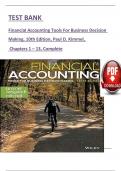Exam (elaborations)
Financial Accounting Tools For Business Decision Making, 10th Edition TEST BANK by Paul D. Kimmel, Jerry J. Weygandt, Verified Chapters 1 - 13, Complete Newest Version
Financial Accounting Tools For Business Decision Making, 10th Edition TEST BANK by Paul D. Kimmel, Jerry J. Weygandt, Verified Chapters 1 - 13, Complete Newest Version TEST BANK For Financial Accounting Tools For Business Decision Making, 10th Edition, Paul D. Kimmel, Jerry J. Weygandt, Verified Ch...
[Show more]



